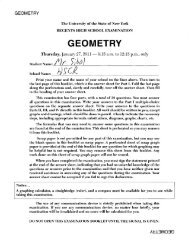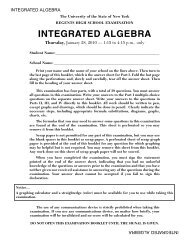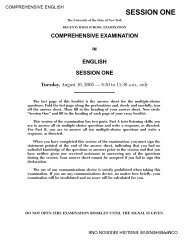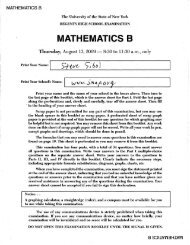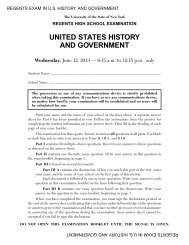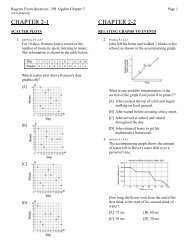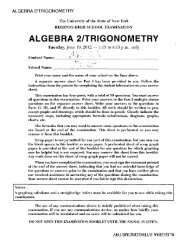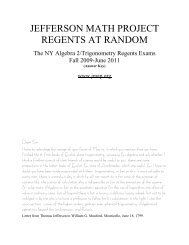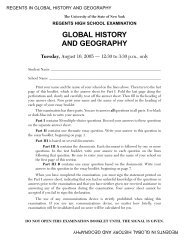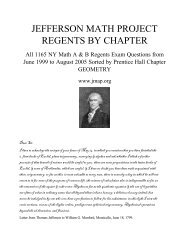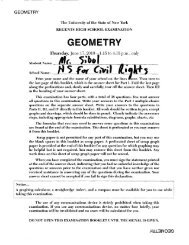9502320 Comp English I Ja06 - JMap
9502320 Comp English I Ja06 - JMap
9502320 Comp English I Ja06 - JMap
You also want an ePaper? Increase the reach of your titles
YUMPU automatically turns print PDFs into web optimized ePapers that Google loves.
55<br />
60<br />
65<br />
70<br />
75<br />
80<br />
85<br />
90<br />
95<br />
Beth Wright, an associate research scientist for the Florida Marine Research<br />
Institutes’ Endangered and Threatened Species Department, tracks about 25 of<br />
these manatees by satellite from her office in St. Petersburg (each manatee has<br />
been fitted with a tag containing a satellite transmitter, a radio transmitter and a<br />
sonic beacon). The telemetric data Wright compiles will help federal agencies<br />
determine where manatees are likely to be found at different times of the year.<br />
This information will be particularly vital to the 13 coastal counties currently<br />
designated as “Manatee Protection Areas.” These counties have been required to<br />
file a three-part plan with the state, identifying boating speed zones, outlining<br />
educational programs and mapping out areas where new docks may be built. The<br />
locations of docks are a critical issue; it’s important that they not be permitted in<br />
areas that the slow-moving mammals are known to frequent. But keeping docks<br />
and manatees apart isn’t always easy. As one marine biologist at the Florida<br />
Marine Research Institute says, “Sometimes ideal manatee habitat and ideal boat<br />
habitat are one and the same.”<br />
In the early 1990s, former Florida Governor Bob Martinez ordered 13 coastal<br />
counties to create manatee protection plans, which would detail where docks,<br />
marinas and boat ramps should go, and mandate slow-speed zones, boater<br />
education and more enforcement. But a decade later, only four counties—<br />
Collier, Dade, Duvall and Citrus—have plans in place, and there are only 400<br />
marine patrol officers to enforce the entire state’s manatee laws.<br />
Because many scientists believe that dredging and dock construction projects<br />
approved by the Army Corps of Engineers and the U.S. Fish and Wildlife Service<br />
are depriving manatees of irreplaceable habitat, a lawsuit was brought against<br />
both agencies in January 2000 by a coalition of environmental groups, including<br />
the Save The Manatee Club, the Humane Society of the United States, the Sierra<br />
Club, Florida Defenders of the Environment and the International Wildlife<br />
Coalition. On April 19, a settlement was reached that calls for the review of eight<br />
areas, including Brevard County (the deadliest county for manatees), for the<br />
adoption of slow speed zones. Additionally, 14 areas are to be reviewed for the<br />
development of manatee refuges and sanctuaries. For more information, visit the<br />
Save The Manatee Club’s website….<br />
Not long ago, I had the opportunity to swim with and photograph Hurricane<br />
and Buffet, two young manatees at the Lowry Park Zoo. The two were recovering<br />
nicely from boat strike injuries and were soon to be released.<br />
I squeezed into my wetsuit and joined one of the zookeepers at the main pool.<br />
She pointed toward a pair of shadows gliding across the bottom. “Let them come<br />
to you,” she said. We entered the water. There was a ledge nearby, about five feet<br />
down. I swam to it. When I looked up, Hurricane, the larger of the two, was three<br />
feet away and closing fast.<br />
The manatee nuzzled my dive mask. It was like looking into the business end<br />
of a big vacuum cleaner. Delighted, I gently pushed him back. He squinted at me.<br />
His eyes were like grey M&M’s. Then he sidled in, presenting his belly for a rub.<br />
His skin was leathery and smooth. The zookeeper gave him a vitamin-laced<br />
biscuit and a brief pat. Then he rejoined his comrade, the two of them spiraling<br />
the length of the pool in a surprising graceful underwater pas de deux. 1<br />
A few months later, fully recovered, Hurricane and Buffet were returned to<br />
the wild.<br />
— James Phillips<br />
excerpted from “Saving Florida’s Sea Cows”<br />
ASPCA Animal Watch, Winter 2001<br />
________________________<br />
1 pas de deux— in ballet, a dance for two performers<br />
<strong>Comp</strong>. Eng. — Session One – Jan. ’06 [7] [OVER]



